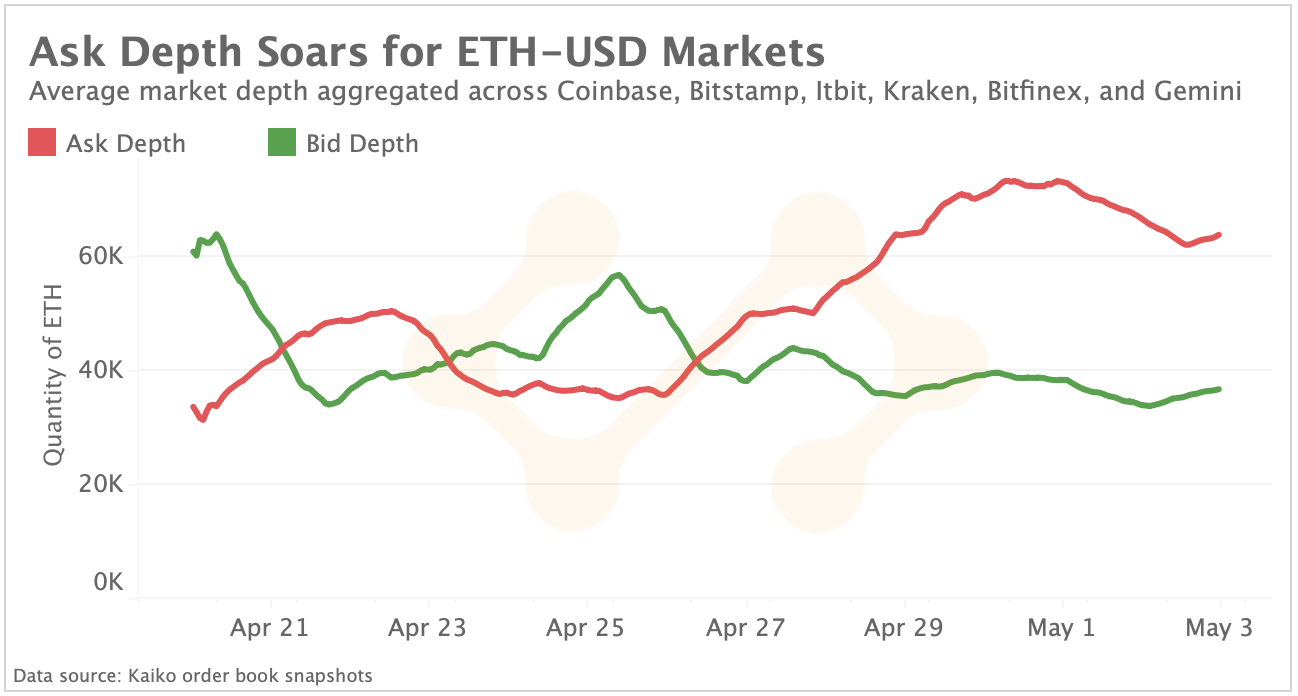A summarizing review of what has been happening at the crypto markets of the past week. A look at trending sectors, liquidity, volatility, spreads and more. The weekly report in cooperation with market data provider Kaiko.
The last 7 days in cryptocurrency markets:
- Price Movements: Ethereum reached a historic new all time high above 3'000 USD early Monday morning.
- Volume Dynamics: 80% of all Tether volume occurs on just four exchanges.
- Order Book Liquidity: The quantity of asks on Ethereum order books has nearly doubled over the past week, which suggests profit taking amidst record highs.
- Volatility and Correlations: Bitcoin's correlation with equities dropped to its lowest level since early January.
Ethereum breaks 3'000 USD

Early Monday morning, Ethereum reached a historic new all time high above 3'000 USD, with the crypto asset now up a whopping 325% year-to-date. The milestone comes as Bitcoin stagnates below $60k, up for the year a (relatively) measly 95%. The rally can be partially attributed to the growing number of regulated ETH investment products and DeFi's continued popularity. In April, the world's first Ethereum ETF began trading on the Toronto Stock Exchange and ETH volumes and open interest on CME recently reached all time highs. Ethereum spot volume as a percentage of Bitcoin volume reached one of its highest daily levels yet at more than 48%, which suggests traders are shifting funds out of Bitcoin and into Ethereum markets.
Majority of Tether volume on loosely regulated exchanges
In this review, we rarely leverage Kaiko's full coverage (100+ exchanges), opting to focus on ~20 exchanges that have strong reputations in the industry. Aggregated volume is complicated to measure and prone to inflation throughout the industry. Over the past couple of years wash trading has become less of a problem on the top exchanges; however, these improvements have not extended down to all of the loosely regulated exchanges out there.
As Coinbase prepares to list Tether (which was delayed), we wanted to explore the breakdown in Tether volume across the spectrum of exchanges. We took the sum of volume for all currency pairs of which Tether is either the base or quote asset and converted these amounts to USD. The results are quite striking in that most of the top 15 exchanges are either loosely regulated or completely unregulated. Tether trades on a number of regulated exchanges (Kraken, Bitfinex, Poloniex), but none of these exchanges falls within the top 15 by volume.
The second most striking observation is the sheer amount of Tether volume that Binance has processed (more than $3 trillion dollars worth over the past year). When looking at the percentage share of Tether volume traded over time, we can observe that the majority occurs on just the top four exchanges (Binance, Huobi, Bit-Z, and Okex).
It has only been over the past year that Binance's Tether market share has grown to be approximately 50% of total Tether volume. While Tether may be systemically important to crypto when considering total aggregated volume, a more accurate phrase based on the data would be "Binance is systemically important to crypto."
With new all time highs, Ethereum ask depth soars
The quantity of asks (limit orders to sell) on ETH-USD order books has nearly doubled over the past week as Ethereum breaks new all time highs. The quantity of asks within 10% of the midprice now significantly outnumbers the quantity of bids. This suggests that traders are taking profits and expect future price rises in the short term. Market buying pressure is currently strong enough to support these price levels, but if buying pressure weakens a pullback could occur. Price discovery is a complex process involving price takers and market makers. Both market depth and the proportion of buy/sell trades can reveal market dynamics, thus order book liquidity is only one side of the story.
Bitcoin's correlation with equities drops to lowest level in months
Bitcoin's correlation to the Nasdaq and S&P 500 equities indices hasn't been this low since early January. The correlation has dropped steadily to .0672 (S&P) and .178 (Nasdaq), barely positive. Gold has been hovering in negative territory since mid-March. The drop in correlation comes as crypto markets experience a new round of volatility that has seen a series of incredible drops and all time highs over the past month.








